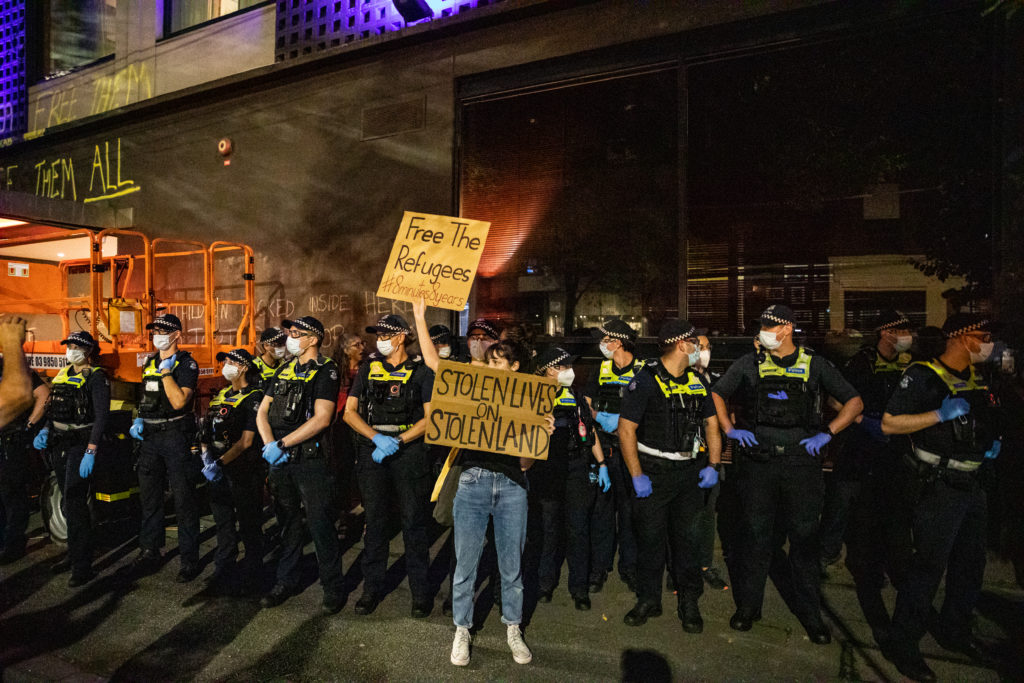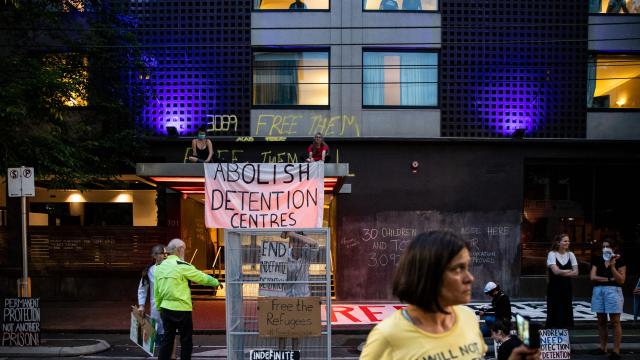If you’ve been following the case of Novak Djokovic’s arrival in Australia closely, you’ll know that it’s been a confusing series of events. After the tennis player landed in Melbourne, his medical exemption from vaccination was not accepted and he was temporarily moved into immigration detention alongside a number of refugees and asylum seekers at the Park Hotel, Melbourne.
You can follow the most recent series of events regarding Djokovic’s visa here.
What we’d like to take a closer look at right now, however, is the Park Hotel and the people detained within it who are not international sporting stars. Because, as many are learning for the first time right now, there is a huge problem at hand here.
Australia’s treatment of people seeking asylum and refugees

As has been broadly reported, the story of Djokovic’s troubles entering into Australia caught the attention of the masses because of the profile of the man at the centre of it.
However, it’s continuing to turn heads not because of the experience of a wealthy man who had his detainment overturned by the court, but because of the treatment of more than 30 refugees and people seeking asylum who have also been held at the Park Hotel.
These people, many of whom have been kept in detention for as long as nine years, have been voicing their distress over the treatment they receive; hoping that the media attention Djokovic has brought will result in a change to their lives.
A recent piece from the New York Times highlighted that the people detained within the Park Hotel have been brought over to Australia from offshore detention for medical treatment, and are not permitted to leave the hotel for any reason aside from medical care.
Asylum seekers and refugees living within the Park Hotel have made complaints about “disgusting” conditions, the ABC writes, with people stating they’ve received maggot-riddled and mouldy food; have been kept in unhygienic environments and even witnessed a number of fires break out in the facility.
A spokesperson from the Australian Border Force (ABF) told the outlet that “management of detainees, whether in an immigration detention centre or APOD, is carried out with primary consideration given to the safety and security of all individuals, staff, and the public”.
Similarly, in the NYT piece, an ABF statement is quoted claiming that people within immigration hotels are offered “access to dedicated indoor and outdoor exercise and activity areas”, appropriate meals, “clean, comfortable sleeping quarters”, and more.
However, Sophie McNeill of Human Rights Watch has since written about how Djokovic’s “case became a jolting reminder of Australia’s abusive treatment of refugees and asylum seekers who have been held in the country’s immigration detention system for years”.
In her piece, which you can read in full here, she explains how thousands of asylum seekers and refugees have been sent to offshore camps in Papua New Guinea and Nauru, with adults and children both enduring traumatic conditions there.
People have died in the offshore detention system, and yet many at home in Australia and abroad are not fully aware of the conditions the people detained in these centres are living under.
Alison Battisson, a human rights lawyer, spoke with the NYT about Australia’s treatment of people seeking asylum and refugees, explaining that the intention behind these places is to “make the conditions so awful you choose to go back to the place of harm you came from”.
Djokovic experienced a few days of something sort of like what the people detained by Australia’s Border Force have lived with for years.
This is not a new problem
Back in 2001, Abbas Nazari — who was 7 years old when he fled Afghanistan with his family — was one of over 400 asylum seekers who were on the fishing boat that was rescued by a Norwegian cargo ship known as the Tampa.
The people on that boat were characterised by the Howard government as untrustworthy; as people trying to “jump the [imaginary] queue” into Australia.
Nazari recently explained to Marie Claire that stepping onto that boat from Afghanistan “it was a life-or-death decision for my parents”.
“Imagine this: you have to choose whether to stay in the life you know and face misery upon misery, or leave and take a chance on the slightest sliver of unseen hope.”
But a hard line was drawn, and since that point, Australia’s general approach to asylum seekers and refugees arriving by boat has remained relatively unchanged.
The Guardian’s Full Story podcast has an episode on this historic and devastating event that, in essence, led us to where we are now. It’s really worth a listen if you have the time.
Mehdi Ali, a 24-year-old Iranian refugee, explained to the NYT that he fled from persecution in Iran at age 15 and has been kept in Australian immigration detention for nine years.
While detailing his experience, Ali shared that when on Nauru island, he would wait for rain in order to take a shower. And now, he is detained in the Park Hotel, with no idea of when his time there will end.
The law tells us that children must only be detained for the shortest period of time, yet I grew up in this cage. Justice is all I ask for. I don’t want to survive anymore. I just want to live. https://t.co/NHponRH2qQ
— Mehdi Ali (@MehdiAli98) January 7, 2022
When asked about the interest Djokovic’s case has brought to the Park Hotel and the people like himself, he told the outlet that he had mixed feelings:
“I kind of get excited about it, that people are getting to know about our circumstance,” he told the NYT.
“But I also get disappointed and I get sad, because why haven’t they known we have been in detention for more than eight years?”
And this solemn point is a completely valid one.
Wherever you stand on the Djokovic story, it’s just impossible to compare his experience to the hardships felt by people seeking asylum and refugees who have not only had to leave their homes in the name of safety but are now left in a painful limbo.
Like with the news of the Taliban’s return in Afghanistan and the case of the Biloela family, these gut-wrenching stories may only remain in the headlines for a short amount of time, but the crisis at hand is certainly not a fleeting one.
We cannot forget that, and we cannot forget the people who are really being hurt by these border policies.
There is an overwhelming feeling of disappointment at the #ParkHotel. The media left when #Djokovic left.
Where is the support for the refugees who are forced to remain after 9 years detention?
No one should allow these people to go back to being alone and forgotten. pic.twitter.com/2QKHWHPTCT— RAC Victoria (@racvictoria) January 11, 2022
While there is a lot of focus on the 32 or so refugees detained in Park Hotel, for those who are just hearing about this, after 9 years there are still over 200 people offshore in PNG and Nauru, and 70 onshore. Those in PNG have been abandoned there by Australia.
— Mehdi Ali (@MehdiAli98) January 10, 2022
Please listen to refugee Mohammed Joy in the Park Hotel, Melbourne, speaking to protesters today.
When the Djokovic saga ends tomorrow, one way or another, the spotlight will move on.
And they’ll still be inside those rooms, crying out for help.
It’s disgusting. #GameOver pic.twitter.com/zxNPIsIYmy
— Craig Foster (@Craig_Foster) January 9, 2022
If you would like to continue to learn about and support people seeking asylum and refugees, you can register for one of the many ways to give with The Asylum Seeker Resource Centre (ASRC), along with organisations like Amnesty International and UNHCR.

Leave a Reply
You must be logged in to post a comment.